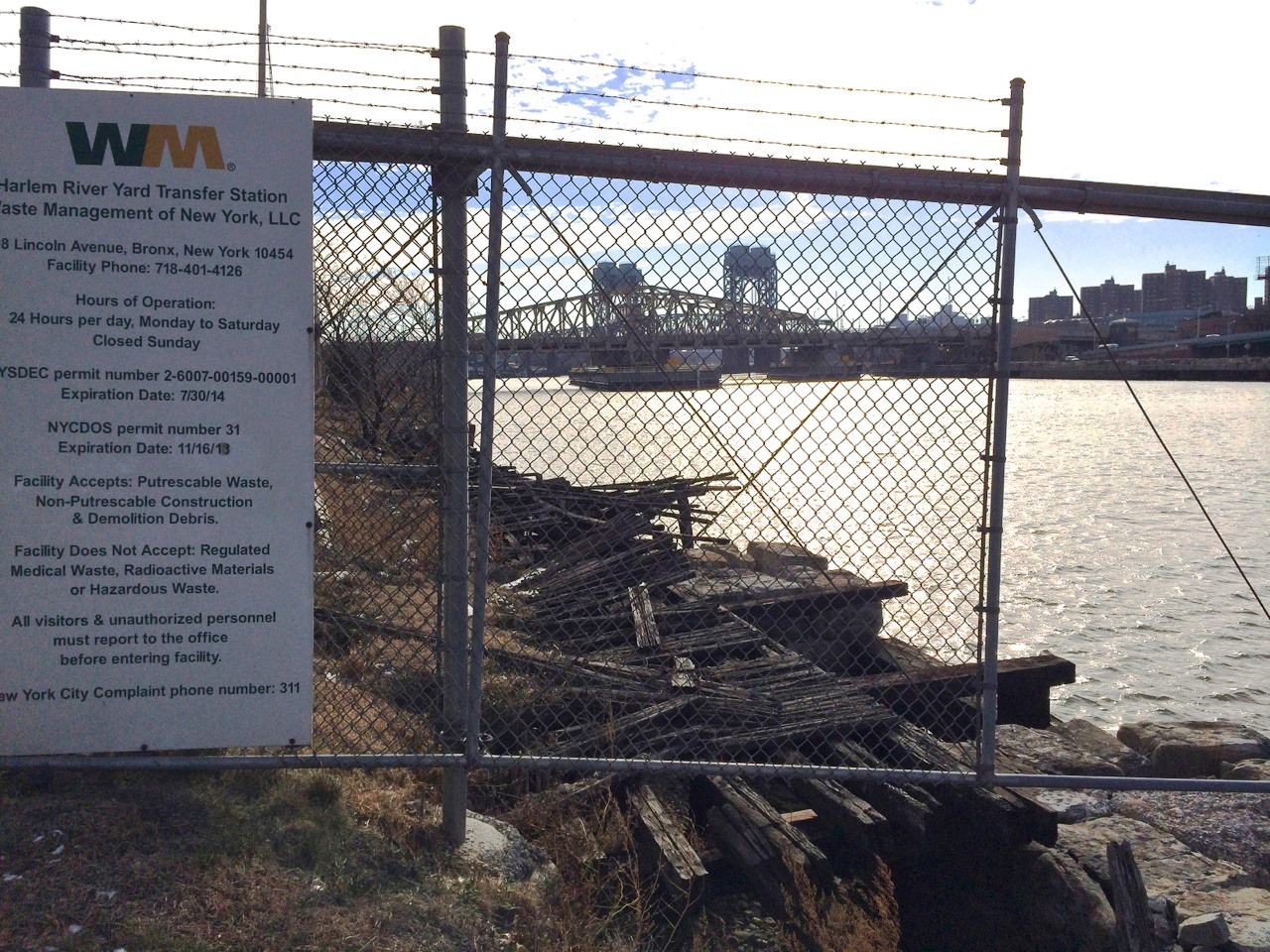
Deterioration leaves area vulnerable to floods
A bulkhead on the shore of the Harlem River is crumbling into the water leaving about 100 yards of state-owned waterfront unprotected from high tides and future storms.
The no man’s land where Lincoln Avenue meets the river includes an ideal site to create recreational water access, according study after study completed by urban planners at several universities in recent years. It continues into the Harlem River rail yard.
Opinions differ on who is responsible for the deterioration of the bulkhead, on how dangerous it is and on how to remedy the situation.
The risks of pollution and flooding make repairing the bulkhead an urgent task, according to community activist Mychal Johnson, a leader of South Bronx Unite.
“This is just ridiculous,” said Johnson. “Why wasn’t this put back in its proper condition?”
But some of the allies of South Bronx Unite contend that the situation offers an opportunity to create a park that would include plantings to form a natural barrier to flooding.
“What you saw in Sandy was that areas with a natural wetland were better able to sustain a storm than a hard edge,” said Chauncy Young of the Harlem River Working Group. “Scientifically a natural edge is better.”
The bulkhead begins at Lincoln Avenue and continues east onto the state-owned Harlem River Yards. Redeveloping that patch of waterfront would not be an easy task, said Anthony Riccio, vice president of the Galesi Group’s Harlem River Yards Ventures, the real estate company that leases the rail yard from the state.
Freight trains usually move between Lincoln Avenue and the Harlem River twice a day, Riccio said. Trains pass through on their way to Long Island or to load and unload at the waste transfer station, which subleases the western portion of the rail yard.
The bulkhead on that section of the property lies in a broken mass of rotting wood and crumbling cement, offering little protection to an area that was under four feet of water during Hurricane Sandy last year.
Erosion has worsened in recent years, according to Harry Bubbins, director of the Mott Haven-based environmental group, Friends of Brook Park. He said that fish, barbecue and launch canoes from Lincoln Avenue. Visitors have a clear view of what Bubbins called the “glaring” erosion of the shoreline, which he blamed on Harlem River Yards Ventures and its parent company.
“That’s just one example of how the Galesi Group have been horrible neighbors,” Bubbins said.
Riccio said that the crumbling structure was likely a relic of former barge docks that predated the 1991 lease of the land between the state Department of Transportation and the Galesi Group.
He acknowledged that Harlem River Yards Ventures is required to maintain the property, but said rebuilding on the water is murky territory that would have to involve various government entities such as the state Department of Environmental Conservation, the Coast Guard and the Army Corps of Engineers.
“Development on the waterfront is not an easy process,” Riccio said. “Any plan there would need to go through a process of review for safety, environmental protection and design.”
Both the DEC and the state transportation department, which owns the land, declined numerous requests for comment.
Rebuilding the bulkhead could create a new problem, according to Young, of the Harlem River Working Group, the community coalition trying to increase waterfront access for Bronxites. Hard edges such as bulkheads and walls create dangerous conditions, according to Young, who said that such a barrier contributed to the 2012 drowning death of a 10-year old boy at Roberto Clemente State Park.
“There was no way for him to get back to the land,” Young said. “It’s a safety concern, not just an access concern, when you cut the community off from the river like that.”
Plans drafted within the last three years by MIT, the Pratt Institute and its Center for Community Development, the city and–most recently-the Rebuild By Design taskforce initiated by the federal government to design protection against future hurricanes have all called for increased protection from erosion and for more recreational waterfront access along the Harlem River.
They have singled out Lincoln Avenue as a “gateway to the greenway.” Several of those plans also propose a soft edge along the property, where the addition of native plants and wetlands could create a buffer.
Natural buffers helped to protect the eastern sections of Harlem River Yards during Sandy, according to Riccio. However, the western portions closer to Lincoln Avenue were under four feet of water at the height of the storm.
While Riccio seemed open to a community-backed solution to the crumbling shoreline, he said the main barrier to recreational access there is the train tracks that separate Lincoln Avenue from the river.
“It’s dangerous for anyone to even think they’d want to go across those tracks,” he said.
Community activists think otherwise.
Train traffic at Lincoln Avenue is minimal, according to Bubbins, who pointed out other parts of the Bronx where train tracks are not barriers to use, including Hunts Point Riverside Park and a crossing near a Yankee Stadium parking lot.
“It’s a unique design consideration that should in no way prohibit access,” he said.


[…] Read it in the Mott Haven Herald […]
[…] a ticket blitz against Bronx merchants made the Mott Haven Herald. Jenna O’Donnell wrote about a crumbling bulkhead along the Hudson […]